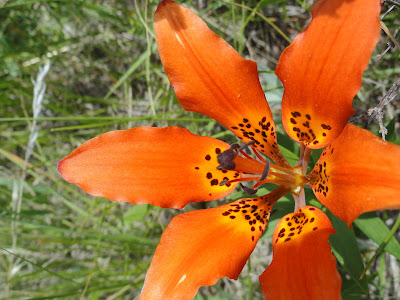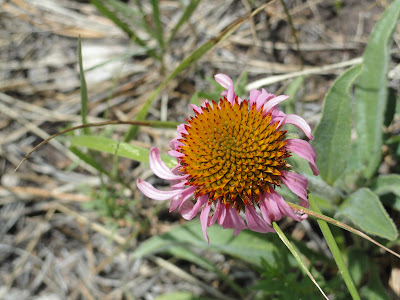And now, on with the show.
One of the perks of working outdoors, in a nature area, is all the cool vegetation that seems to spring up all season long. Some of it's native to the area; some of it is introduced. But it's all lovely.
 |
| Yellow Salsify, Trogopogon Dubius |
If the name "salsify" sounds kinda familiar, there's a purple variety that folks used to grow in their vegetable gardens. It was also called "oyster plant", as the roots tasted kinda like oysters when cooked. Me personally, I'll have to pass on those.
 |
| Western Wood Lily, Lilium philadelphicum |
These grow in ones and twos, and seem to just pop out of the grass. They aren't really rare, but they are uncommon, so seeing them is a bit of a treat.
 |
| Dame's Rocket, Hesperis matronalis |
Dame's Rocket is part of the "Brassicaceae" family, which also includes cabbage, broccoli and radish. This is given away by the four petaled flowers, which give the family an alternate name: Cruciferae, since the petals form a bit of a "cross". It was planted in gardens a long time ago and has since been naturalized, growing across most of the US.
 |
| Gunnison's Mariposa Lily, Calochortus gunnisonii, and Goldenrod Crab Spider, Misumena vatia. |
These guys run from white to purpleish. It took me a while to get this particular shot; the breeze kept blowing the flower around and the little spider friend kept wanting to hide under the flower. But I sat patiently for a while and he finally came out and waved at me. Good luck hunting the bugs, little dude!
 |
| Purple Coneflower, Echinacea angustifolia |
These guys, like the Salsify plant at the top of the page, are part of the "composite" (Compositae) or Aster family. The "Composite" part is because there's two types of flowers: the "disk" flowers make up the middle; the "ray" flowers are along the outer edge and consist of a disk flower with a petal attached to it. The wild ones look a little different than the garden variety types: domesticated ones were bred to make the petals larger and more showy.
That's all from the garden for now!
I can't believe it's AUGUST already. It has been a long, hot summer, yet it's seemingly gone by in the blink of an eye.
Catch you on the flipside!
Aye,
Kraneia
Bonus Bloom!



No comments:
Post a Comment
comments are moderated, so please be patient and submit only once ;)